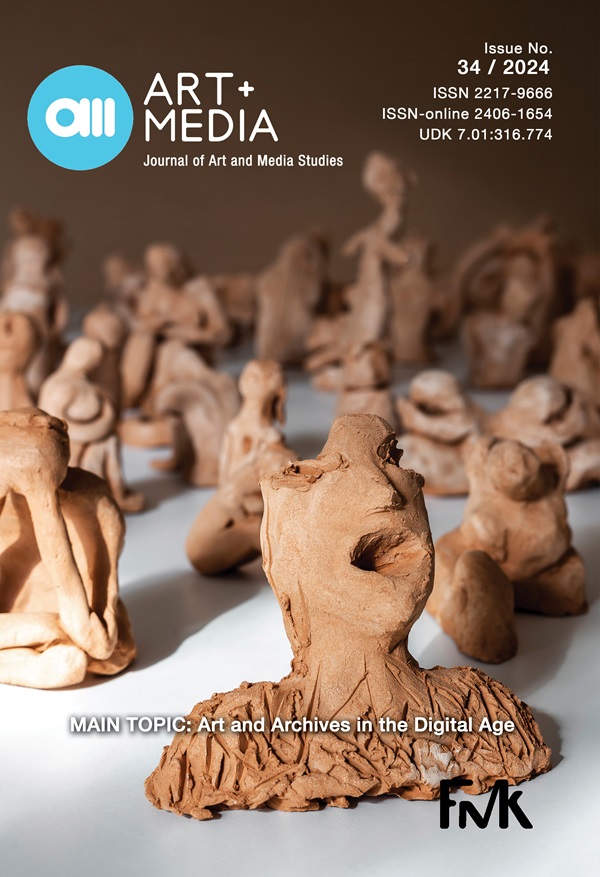Digital Games and The City: About Reality, Commuting and Gamification
DOI:
https://doi.org/10.25038/am.v0i28.561Abstract
This paper is part of a research on gaming and reality carried out by the Laboratório de Poéticas Fronteiriças, a research group rolled on the CNPq’s directory and certified by the UEMG (Brazil). Growing number of phone programs that provide ride-share services, transportation, or product delivery, primarily food, remind us of old games that use similar mechanisms. Our aim is to analyze the games series Crazy Taxi and Grand Theft Auto, their narrative and aesthetic elements as well as similarities to the Uber app in order to better understand ways the gamification of such types of apps can allow a re-signification of the city spaces, its users as players and of its socio-economic impact.
References
Andersen, Niels Åkerstrøm. Power at Play: The Relationships between Play, Work and Governance. New York: Palgrave Macmillan, 2009. https://doi.org/10.1057/9780230239296. DOI: https://doi.org/10.1057/9780230239296
Arce, M. Avendaño. “Cabify, La Competencia de Uber se Prepara para Operar en Costa Rica.” La Nacion. https://www.nacion.com/economia/negocios/cabify-la-competencia-de-uber-se-prepara-para-operar-en-costa-rica/UTJMTPKNYNGHNP3BPPI5LPU3RM/story/. Accessed on August 21, 2024.
Berger, Peter, and Thomas Luckmann. The Social Construction of Reality: A Treatise in the Sociology of Knowledge. London: Penguin Books Limited, 1991.
Cherry, Miriam. “The Gamification of Work.” Hofstra Law Review 40, 4 (January 1, 2012): 851–58. https://scholarlycommons.law.hofstra.edu/hlr/vol40/iss4/2.
Cradeur, Jay. “The Gamification of the Rideshare Driver Experience.” The Rideshare Guy, October 10, 2018. https://therideshareguy.com/gamification-of-rideshare-driving/. Accessed on February 25, 2024.
Debord, Guy. “Teoria da Deriva.” In Apologia da Deriva: Escritos Situacionistas sobre a Cidade, edited by Paola B. Jaques, 87–91. Rio de Janeiro: Casa da Palavra, 2003.
Deterding, Sebastian, Dan Dixon, Rilla Khaled, and Lennart Nacke. “From Game Design Elements to Gamefulness: Defining Gamification.” Proceedings of the 15th International Academic MindTrek Conference: Envisioning Future Media Environments, 9–15. Finland: MindTrek, 2011. DOI: https://doi.org/10.1145/2181037.2181040
Farr, Christina. “Lyft Team Gets $60M More; Now It Must Prove Ride-Sharing Can Go Global.” Venture Beat. https://venturebeat.com/2013/05/23/lyft-races-ahead-with-60m-in-funding-but-what-challenges-lie-ahead/. Accessed on August 21, 2024.
Gobira, Pablo. “Comentários Perfunctórios Sobre Jogos Digitais E Seu Potencial Narrativo.” In Design+: arte, ciência e technologia: conexões teórico-práticas. Edited by Débora Aita Gasparetto, 134–140. Santa Maria RS: Editora PPGART, 2017.
Hall, Jonathan V., and Alan B. Krueger. “An Analysis of the Labor Market for Uber’s Driver-Partners in the United States.” ILR Review 71, 3 (June 29, 2017): 705–32. DOI: https://doi.org/10.1177/0019793917717222
Hitmaker. Crazy Taxy. Sega. 1999.
Huizinga, Johan. Homo Ludens: A Study of the Play-Element in Culture. London: Routledge and Kegan Paul, 1980.
Internacional Situacionista. “Contribuição para uma Definição Situacionista de Jogo.” In Apologia da Deriva: Escritos Situacionistas sobre a Cidade, edited by Paola B. Jacques, 60–61. Rio de Janeiro: Casa da Palavra, 2003.
Iqbal, Mansoor. “Uber Revenue and Usage Statistics (2024).” Business of Apps, January 15, 2024. https://www.businessofapps.com/data/uber-statistics/. Accessed on February 25, 2024.
Jacques, Paola. B. “Apresentação.” In Apologia da Deriva: Escritos Situacionistas sobre a Cidade, edited by Paola B. Jacques, 13–36. Rio de Janeiro: Casa da Palavra, 2003.
Keithcr. Rideshare. Grand Theft Auto V: Rockstar Games. 2017.
Khatib, Abdelhafid. “Esboço de Descrição Psicogeográfica do Les Halles de Paris.” In Apologia da Deriva: Escritos Situacionistas sobre a Cidade, edited by Paola B. Jacques, 79–84. Rio de Janeiro: Casa da Palavra, 2003.
Marquers, Julia. “O Que Significa Uber? Confira Perguntas E Respostas Sobre O Aplicativo.” TechTudo, June 15, 2019. https://www.techtudo.com.br/noticias/2019/06/o-que-significa-uber-confira-perguntas-e-respostas-sobre-o-aplicativo.ghtml. Accessed on July 13, 2024.
Mason, Sarah. “High Score, Low Pay: Why the Gig Economy Loves Gamification.” The Guardian. November 20, 2018. https://www.theguardian.com/business/2018/nov/20/high-score-low-pay-gamification-lyft-uber-drivers-ride-hailing-gig-economy. Accessed on February 25, 2024.
McGonigal, Jane. Reality is Broken: Why Games Make Us Better and How They Can Change the World. New York: Penguin Press, 2011.
Mota, Rosilane R., and Marinho, Francisco C. “Jogo Digital: Aspectos Psicofisiológicos no Processo de Imersão.” In SBC – Proceedings of SBGames, 1145–54. Rio Grande do Sul: Porto Alegre, 2014.
Nelson, Mark J. “Soviet and American Precursors to the Gamification of Work.” In MindTrek 2012: Proceeding of the 16th International Academic MindTrek Conference, 2012, 23–26. https://doi.org/10.1145/2393132.2393138. Accessed on February 25, 2024. DOI: https://doi.org/10.1145/2393132.2393138
Olyslager, Paul. “How Uber Gamification Manipulates Drivers.” Paul Olyslager, 2017. https://www.paulolyslager.com/how-Uber-gamification-manipulate-drivers/. Accessed on February 13, 2024.
Perniola, Mario. Os Situacionistas: O Movimento que Profetizou a ‘Sociedade do Espetáculo’. São Paulo: Annablume, 2009.
Pilon, Mary. “Monopoly Was Designed to Teach the 99% about Income Inequality.” Smithsonian Magazine, January 2015. https://www.smithsonianmag.com/arts-culture/monopoly-was-designed-teach-99-about-income-inequality-180953630/. Accessed on February 25, 2024.
Pilon, Mary. “Monopoly’s Inventor: The Progressive Who Didn’t Pass ‘Go.’” The New York Times, August 21, 2024. https://www.nytimes.com/2015/02/15/business/behind-monopoly-an-inventor-who-didnt-pass-go.html. Accessed on February 25, 2024.
Rockstar North. Grand Theft Auto. Rockstar Games. 1997.
Rosenblat, Alex, and Luke Stark. “Algorithmic Labor and Information Asymmetries: A Case Study of Uber’s Drivers.” International Journal of Communication 10, 0 (July 27, 2016): 27. https://ijoc.org/index.php/ijoc/article/view/4892/.
Scheiber, Noam. “How Uber Uses Psychological Tricks to Push Its Drivers’ Buttons.” The New York Times, April 2, 2017. https://www.nytimes.com/interactive/2017/04/02/technology/uber-drivers-psychological-tricks.html. Accessed on August 21, 2024.
Yee, Nick. “The Labor of Fun: How Video Games Blur the Boundaries of Work and Play.” Games and Culture 1, 1 (January 2006): 68–71. https://doi.org/10.1177/1555412005281819 DOI: https://doi.org/10.1177/1555412005281819
Zhang, Maggie. “UberDRIVE: A Mobile Game to Recruit and Train Uber Drivers.” Forbes, June 12, 2015. https://www.forbes.com/sites/mzhang/2015/06/12/uberdrive/?sh=6179705061ac. Accessed on February 25, 2024.
Zyda, Michael. “From Visual Simulation to Virtual Reality to Games.” Computer 38, 9 (September 2005): 25–32. https://doi.org/10.1109/mc.2005.297. DOI: https://doi.org/10.1109/MC.2005.297
Downloads
Published
How to Cite
Issue
Section
License
Copyright (c) 2024 AM Journal of Art and Media Studies

This work is licensed under a Creative Commons Attribution 4.0 International License.
The content on this site is licensed under a Creative Commons Attribution 4.0 International License.
AM Journal of Art and Media Studies ISSN 2217-9666 - printed, ISSN 2406-1654 - online, UDK 7.01:316.774
Contact: amjournal@outlook.com
Publisher: Faculty of Media and Communications, Singidunum University, Belgrade, Serbia
Indexed in: ERIH PLUS, EBSCO, DOAJ, and in The List of Scientific Journals Categorization of Ministry of Education, Science and Technological Development of Republic of Serbia (M24 in 2021; M23 in 2023). Beginning with No. 12 2017, AM is indexed, abstracted and covered in Clarivate Analytics service ESCI.

